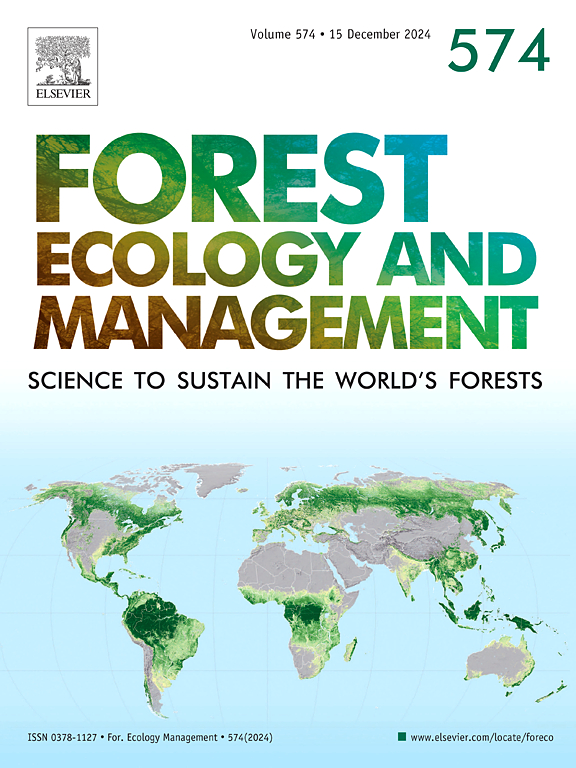桉树人工林自然更新后树种功能组成的恢复在不同林冠层间存在差异
IF 3.7
2区 农林科学
Q1 FORESTRY
引用次数: 0
摘要
树木单一栽培已在全球推广,以供应木材;然而,本地树木的高度多样性可以建立在管理不那么集中的种植园中,既可以收获木材,又可以向更自然的森林过渡。然而,人们对人工林下原生树木的功能恢复知之甚少,而这对生物多样性保护和生态系统服务至关重要。在这里,我们评估了两种恢复方法(自然再生桉树人工林和自然再生森林)之间树木地层的功能组成的差异,以及这是如何受到林龄、气候水分亏缺和土壤特征的影响的。我们在巴西本文章由计算机程序翻译,如有差异,请以英文原文为准。
Recovery of tree species functional composition in eucalypt plantations with natural regeneration differs among canopy strata
Tree monocultures have been promoted globally to supply timber; yet, a high diversity of native trees can establish in less intensively managed plantations, allowing to both harvest timber and transition towards a more natural forest. However, little is known about the functional recovery of native trees under plantations, which is critical for biodiversity conservation and ecosystem services. Here, we evaluate how functional composition of tree strata differs between two restoration methods (eucalypt plantations with natural regeneration and naturally regenerating forests) and how this is affected by stand age, climatic water deficit, and soil characteristics. We established 129 plots in two restoration methods and mature forest as reference, in São Paulo state, Brazil. We divided tree stratum in each plot into different canopy strata using perfect plasticity approximation. We measured five key traits that are important for fire resistance (bark thickness), drought tolerance (wood density), productivity (specific leaf area and leaf thickness), and nutrient cycling (nitrogen-fixing ability) for 393 species and calculated for each stratum community-weighted mean trait values. Community traits were mostly affected by canopy strata, the interaction between canopy strata and restoration method, and water availability. Eucalypt trees dominated the upper strata of plantations, presenting higher wood density, tougher leaves, and thicker bark, reflecting the drought and fire adaptation of eucalypts. The lower strata of eucalypt plantations and naturally regenerating forests had similar functional composition. Our results suggest that eucalypt plantations can be used as a tool to facilitate natural regeneration and restore ecosystem functioning in degraded areas.
求助全文
通过发布文献求助,成功后即可免费获取论文全文。
去求助
来源期刊

Forest Ecology and Management
农林科学-林学
CiteScore
7.50
自引率
10.80%
发文量
665
审稿时长
39 days
期刊介绍:
Forest Ecology and Management publishes scientific articles linking forest ecology with forest management, focusing on the application of biological, ecological and social knowledge to the management and conservation of plantations and natural forests. The scope of the journal includes all forest ecosystems of the world.
A peer-review process ensures the quality and international interest of the manuscripts accepted for publication. The journal encourages communication between scientists in disparate fields who share a common interest in ecology and forest management, bridging the gap between research workers and forest managers.
We encourage submission of papers that will have the strongest interest and value to the Journal''s international readership. Some key features of papers with strong interest include:
1. Clear connections between the ecology and management of forests;
2. Novel ideas or approaches to important challenges in forest ecology and management;
3. Studies that address a population of interest beyond the scale of single research sites, Three key points in the design of forest experiments, Forest Ecology and Management 255 (2008) 2022-2023);
4. Review Articles on timely, important topics. Authors are welcome to contact one of the editors to discuss the suitability of a potential review manuscript.
The Journal encourages proposals for special issues examining important areas of forest ecology and management. Potential guest editors should contact any of the Editors to begin discussions about topics, potential papers, and other details.
 求助内容:
求助内容: 应助结果提醒方式:
应助结果提醒方式:


